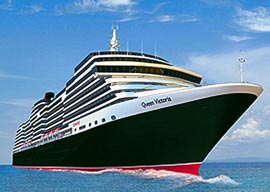
September 05, 2015

On board the M/SQueen Victoria: They remain engraved in my brain, like something out of a Greek tragedy, so beautiful, such legends, and then they were gone. I am referring, of course, to those ocean liners of a bygone era, those romantic boats that dreams were made of, a fantasy world of Aubusson carpets and Lalique lamps gone to sea. As an impressionable young boy crossing the ocean with my parents, there were no finer rooms afloat, and every couple dancing at night in the various ballrooms looked like Fred and Ginger, elegant, romantic, and as graceful as the ships.
The first time I crossed was 1952, on the Constitution, delivered that year from Bethlehem Steel, a cool beauty with the classic counter stern and a noticeable rake on her superstructure. Two multicolored funnels distinguished her from afar. She had red-topped, circular cocktail tables and steel paneling, giving her a futuristic look that an impressionable young boy did not soon forget. This was an unforgettable trip, and a beautiful young Texan, Isla Cowan, played a large part in making it unforgettable. On the return, it was a Norwegian’s turn, Olga’s girl, Olga being a famous shipowner.
After that came French liners, whose china, silver, and furniture were of the highest quality, with creaking wooden paneling, the mandatory three classes—first, cabin, and tourist—and the inevitable shipboard romance. Those were the days, carefree, irresponsible as hell, and with unsurpassed service. The stewards on board in first class were all Jeeves’ doubles. Nothing ever went missing, every bit of clothing was cleaned and pressed in no time, and their discretion made a deep-cover CIA agent look as conspicuous as a barker at the fair.
Mind you, the elegance was also on the part of the passengers. Because of the shipping connection, I was seated more often than not at the captain’s table, along with other swells and a film star or two. It was black tie at dinner except for the first and last night on board. First class consisted of about 250 people, many of them familiar with one another. It all came to an end with the Jet Age, which began in earnest during the late ’50s. By the mid-’60s the writing was on the wall and the cruising had begun. Most of those incredibly graceful beauties of the seas were demolished, turned into scrap, and sold for a pittance.
Which brings me to today. Sumptuous three and four stackers are no more, replaced by smoke-free liners with swiveling pods at the stern that push the ship through the water, eliminating shafts and rudders. They are in reality floating resorts, towering multidecked behemoths, pseudo-lavish lounges, and the class system gone with the wind. Close to 1,000 feet long and 120 feet wide, they are taller by 50 feet than the Statue of Liberty, carrying more than 2,000 people, all classless, pun intended. Theseus, who solved the Minoan Labyrinth, would not have made the cut on board the Queen Victoria, where the Spectator group met last week for a memorable get-together. First, the good news:
It might sound a bit toe-curling, but I have yet to meet a nicer and more joyous group of people, full of life and not an unearned swagger among them. I will only mention Christian names, Arnold and Penny from South Africa, Andrew from Australia—incidentally, a great cross-country skier, champion, and coach—Maureen and David from Liverpool via Edinburgh and Surrey, James and Pat from Biarritz, Fanny and Sue from Belsize Park, and Elizabeth from New Zealand, who flew 16 hours in order to meet a couple of goofballs like Jeremy Clarke and yours truly. She breeds thoroughbreds. Ken and Caroline from London, Woodie and Nicola, Philip and Renee from Cape Town, and many others who loved our Martin Vander Weyer’s and Jonathan Ross’ speeches and even laughed at my rather ribald story of Spectator life since 1977.